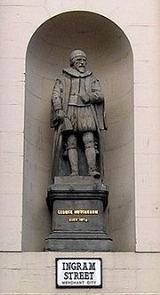
Glasgow's public statues
Encyclopedia
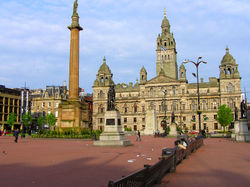
Glasgow
Glasgow is the largest city in Scotland and third most populous in the United Kingdom. The city is situated on the River Clyde in the country's west central lowlands...
, the largest city
City
A city is a relatively large and permanent settlement. Although there is no agreement on how a city is distinguished from a town within general English language meanings, many cities have a particular administrative, legal, or historical status based on local law.For example, in the U.S...
in Scotland
Scotland
Scotland is a country that is part of the United Kingdom. Occupying the northern third of the island of Great Britain, it shares a border with England to the south and is bounded by the North Sea to the east, the Atlantic Ocean to the north and west, and the North Channel and Irish Sea to the...
, have been used to display the wealth and history of the city over centuries. The most prominent are those erected by the municipality or by public subscription, but others adorn the façades of the great commercial buildings.
George Square
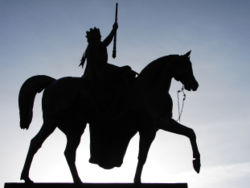
George Square
George Square is the principal civic square in the city of Glasgow, Scotland. It is named after King George III.-Historical development:George Square was laid out in 1781, part of the innovative Georgian central grid plan that initially spanned from Stockwell Street east to Buchanan Street—which...
is Glasgow's central public square, which stands in front of the landmark City Chambers
Glasgow City Chambers
The City Chambers in Glasgow, Scotland has functioned as the headquarters of Glasgow City Council since 1996, and of preceding forms of civic government in the city since 1889, located on the eastern side of the city's George Square...
. The square was laid out in 1782, with houses appearing between 1874 and 1820. Many of these later became hotels, especially after the opening of Queen Street Station
Glasgow Queen Street railway station
Glasgow Queen Street is a railway station in Glasgow, Scotland, the smaller of the city's two main line railway termini and the third-busiest station in Scotland. It is between George Street to the south and Cathedral Street Bridge to the north, at the northern end of Queen Street adjacent to...
. Only one of the original houses remains - the Millennium Hotel beside the station. The square is now a magnificent public space dominated by the aforesaid City Chambers, the ex-Post Office, ex-Bank of Scotland
Bank of Scotland
The Bank of Scotland plc is a commercial and clearing bank based in Edinburgh, Scotland. With a history dating to the 17th century, it is the second oldest surviving bank in what is now the United Kingdom, and is the only commercial institution created by the Parliament of Scotland to...
and the Merchant's House. During the 19th century, statues to the greatness of Glaswegian, Scottish and British culture were erected. They included poets, adventurers, soldiers, scientists and politicians (local and national), as well as the Queen and Prince Consort. They are all realistic portraits in the 19th century style. They are:
- The Scott Monument - 1837 Column by David Rhind and statue of Sir Walter ScottWalter ScottSir Walter Scott, 1st Baronet was a Scottish historical novelist, playwright, and poet, popular throughout much of the world during his time....
by John Greenshields carved by Handyside Ritchie.
- The CenotaphCenotaphA cenotaph is an "empty tomb" or a monument erected in honour of a person or group of people whose remains are elsewhere. It can also be the initial tomb for a person who has since been interred elsewhere. The word derives from the Greek κενοτάφιον = kenotaphion...
- 1921 -24 by Sir J J Burnet Lions and figure of St Mungo by Ernest Gillick, a memorial to the city's fallen in the Great War and other conflicts.
- Thomas GrahamThomas Graham (chemist)Thomas Graham FRS was a nineteenth-century Scottish chemist who is best-remembered today for his pioneering work in dialysis and the diffusion of gases.- Life and work :...
, Chemist – 1872 by William BrodieWilliam BrodieWilliam Brodie , more commonly known by his prestigious title of Deacon Brodie, was a Scottish cabinet-maker, deacon of the trades guild and Edinburgh city councillor, who maintained a secret life as a burglar, partly for the thrill, and partly to fund his gambling.-Career:By day, Brodie was a...
cast by R Masefield and Son of Chelsea
- Thomas Campbell man of letters – 1877 by John MossmanJohn MossmanJohn Mossman was one of a number of English sculptors who dominated the production and teaching of sculpture in Glasgow for 50 years after his arrival with his father and brothers from his native London in 1828...
- Lord ClydeColin Campbell, 1st Baron ClydeField Marshal Colin Campbell, 1st Baron Clyde GCB, KSI was a British Army officer from Scotland who led the Highland Brigade in the Crimea and was in command of the ‘Thin red line’ at the battle of Balaclava...
, Indian Army commander – 1868 by J H Foley
- Sir John MooreJohn Moore (British soldier)Lieutenant-General Sir John Moore, KB was a British soldier and General. He is best known for his military training reforms and for his death at the Battle of Corunna, in which his force was defeated but gained a tactical advantage over a French army under Marshal Soult during the Peninsular...
, Peninsular War commander – 1819 by John FlaxmanJohn FlaxmanJohn Flaxman was an English sculptor and draughtsman.-Early life:He was born in York. His father was also named John, after an ancestor who, according to family tradition, had fought for Parliament at the Battle of Naseby, and afterwards settled as a carrier or farmer in Buckinghamshire...
- Robert BurnsRobert BurnsRobert Burns was a Scottish poet and a lyricist. He is widely regarded as the national poet of Scotland, and is celebrated worldwide...
, Poet – 1877 by George Edwin Ewing, reliefs by J A Ewing cast by Cox and Son.
- James WattJames WattJames Watt, FRS, FRSE was a Scottish inventor and mechanical engineer whose improvements to the Newcomen steam engine were fundamental to the changes brought by the Industrial Revolution in both his native Great Britain and the rest of the world.While working as an instrument maker at the...
, engineer and inventor – 1832 by Chantrey
- Queen VictoriaVictoria of the United KingdomVictoria was the monarch of the United Kingdom of Great Britain and Ireland from 20 June 1837 until her death. From 1 May 1876, she used the additional title of Empress of India....
equestrian – 1854 by Baron Marochetti.
- Prince Albert of Saxe-Coburg and Gotha , equestrian - 1866 by Baron Marochetti.
- Robert PeelRobert PeelSir Robert Peel, 2nd Baronet was a British Conservative statesman who served as Prime Minister of the United Kingdom from 10 December 1834 to 8 April 1835, and again from 30 August 1841 to 29 June 1846...
, Prime Minister – 1859 by John MossmanJohn MossmanJohn Mossman was one of a number of English sculptors who dominated the production and teaching of sculpture in Glasgow for 50 years after his arrival with his father and brothers from his native London in 1828...
- William Ewart GladstoneWilliam Ewart GladstoneWilliam Ewart Gladstone FRS FSS was a British Liberal statesman. In a career lasting over sixty years, he served as Prime Minister four separate times , more than any other person. Gladstone was also Britain's oldest Prime Minister, 84 years old when he resigned for the last time...
, Prime Minister – 1902 by Hamo ThornycroftHamo ThornycroftSir William "Hamo" Thornycroft, RA was a British sculptor, responsible for several London landmarks.-Biography:...
.
- James Oswald, Member of Parliament – 1856 by Baron Marochetti.
Royal Exchange Square

Royal Exchange Square
Royal Exchange Square is a public square in the City of Glasgow in Scotland. The square is situated at the junction of Queen Street with Ingram Street...
outside the Glasgow Gallery of Modern Art and forming an end to Ingram Street is an equestrian statue of the Duke of Wellington
Wellington Statue, Glasgow
The equestrian Wellington Statue, with a humorous traffic cone on its head, on Royal Exchange Square in Glasgow, Scotland, is one of the city's most iconic images...
by Italian artist Carlo Marochetti
Carlo Marochetti
Baron Carlo Marochetti was a sculptor, born in Turin but raised in Paris as a French citizen.-Life:Carlo Marochetti was born on 4 January 1805. His first teachers were François Joseph Bosio and Antoine-Jean Gros in Paris. Here his statue of A Young Girl playing with a Dog won a medal in 1829, and...
, erected in 1844. Capping the statue with a traffic cone
Traffic cone
Traffic cones, also called traffic pylons, road cones, highway cones, safety cones, construction cones or witches' hats or safety wizards, are usually cone-shaped markers that are placed on roads or footpaths to temporarily redirect traffic in a safe manner...
has become a traditional practice in the city, claimed to represent the humour of the local population and believed to date back to the first half of the 1980s if not before. The statue is a Category-A listed monument and due to minor damage and the potential for injury that the placing of cones involves, the practice has been discouraged by Glasgow City Council and Strathclyde Police
Strathclyde Police
Strathclyde Police is the territorial police force responsible for the Scottish council areas of Argyll and Bute, City of Glasgow, East Ayrshire, East Dunbartonshire, East Renfrewshire, Inverclyde, North Ayrshire, North Lanarkshire, Renfrewshire, South Ayrshire, South Lanarkshire and West...
in recent years.
Cathedral
No pre-ReformationScottish Reformation
The Scottish Reformation was Scotland's formal break with the Papacy in 1560, and the events surrounding this. It was part of the wider European Protestant Reformation; and in Scotland's case culminated ecclesiastically in the re-establishment of the church along Reformed lines, and politically in...
statuary remains on the façade of the ancient Glasgow Cathedral
Glasgow Cathedral
The church commonly known as Glasgow Cathedral is the Church of Scotland High Kirk of Glasgow otherwise known as St. Mungo's Cathedral.The other cathedrals in Glasgow are:* The Catholic Metropolitan Cathedral Church of Saint Andrew...
, the city's High Kirk, constructed between 1181 and 1277 and standing as Scotland's largest pre-Reformation church. The cathedral is dedicated to St Mungo (otherwise known as St Kentigern), Glasgow's patron saint. Mungo died in 612 and was buried near his cell by the Molendinar Burn
Molendinar Burn
The Molendinar Burn is a stream in Glasgow, Scotland. It was the site of the settlement that grew to become the kernel of Glasgow, and where St Mungo founded his church in the 6th century. It was later used to power the growing town's mills....
. His shrine remains in the crypt of the cathedral.
There is a portrait head of 'George Bailie, philanthropist' (1873 by J Burnet and John Mossman
John Mossman
John Mossman was one of a number of English sculptors who dominated the production and teaching of sculpture in Glasgow for 50 years after his arrival with his father and brothers from his native London in 1828...
) on a tomb to west of the south door of the Cathedral.
Cathedral Square
The area in front of the Cathedral is dotted with unremarkable portraits of locally renowned benefactors. However, there is a splendid portrayal of David LivingstoneDavid Livingstone
David Livingstone was a Scottish Congregationalist pioneer medical missionary with the London Missionary Society and an explorer in Africa. His meeting with H. M. Stanley gave rise to the popular quotation, "Dr...
, the famous medical missionary, leaning on a palm tree, below which is a set of discarded leg-irons. On the plinth are pictorial reliefs of grateful natives. It was erected in George Square
George Square
George Square is the principal civic square in the city of Glasgow, Scotland. It is named after King George III.-Historical development:George Square was laid out in 1781, part of the innovative Georgian central grid plan that initially spanned from Stockwell Street east to Buchanan Street—which...
in 1875-9 and is by John Mossman
John Mossman
John Mossman was one of a number of English sculptors who dominated the production and teaching of sculpture in Glasgow for 50 years after his arrival with his father and brothers from his native London in 1828...
. It was moved from George Square in 1959.
The other statues are:
- James Lumsden (1778–1856) was a local benefactor. This statue was erected in 1862 and is by John MossmanJohn MossmanJohn Mossman was one of a number of English sculptors who dominated the production and teaching of sculpture in Glasgow for 50 years after his arrival with his father and brothers from his native London in 1828...
. Lumsden was Lord Provost of Glasgow from 1843 to 1846 and he is wearing his chain of office. The statue was originally meant to stand at the gates of the NecropolisNecropolisA necropolis is a large cemetery or burial ground, usually including structural tombs. The word comes from the Greek νεκρόπολις - nekropolis, literally meaning "city of the dead"...
as a pair to that of James Arthur below.
- James White of Overtoun (1812–1844) was a local employer. This was set up in 1890 and is by John Mossman and finished by Frank Leslie. White was a businessman and lawyer, heavily engaged in philanthropic work.
- James Arthur (1819–1895), was a local businessman – 1893 by G. A. LawsonG. A. LawsonGeorge Anderson Lawson was a Victorian era sculptor who was associated with the New Sculpture movement.Lawson was born in Edinburgh. He studied in Glasgow, and settled in London in 1866. His reputation was established through the creation of statues of distinguished citizens...
. This was erected by subscription; among the subscribers were many of his employees.
In the square proper are portrayals of more significant historical personages. In the northwest corner is the Rev Dr Norman Macleod, chaplain to Queen Victoria
Victoria of the United Kingdom
Victoria was the monarch of the United Kingdom of Great Britain and Ireland from 20 June 1837 until her death. From 1 May 1876, she used the additional title of Empress of India....
– 1881-2 by John Mossman
John Mossman
John Mossman was one of a number of English sculptors who dominated the production and teaching of sculpture in Glasgow for 50 years after his arrival with his father and brothers from his native London in 1828...
and cast by Cox & Son. (The Reverend Doctor is shown on the relief on Queen Victoria’s statue in George Square, receiving her to the cathedral on her visit to Glasgow)
In the centre of the square is an impressive equestrian statue of William II of Scotland
William III of England
William III & II was a sovereign Prince of Orange of the House of Orange-Nassau by birth. From 1672 he governed as Stadtholder William III of Orange over Holland, Zeeland, Utrecht, Guelders, and Overijssel of the Dutch Republic. From 1689 he reigned as William III over England and Ireland...
(William of Orange) as a Roman emperor. It was erected at Glasgow Cross in 1735, at the expense of James Macrae
James Macrae
James Macrae was a Scottish seaman and administrator who served as the President of Fort St George from 1725 to 1730. He is known for naval exploits against the pirate Edward England and for reforming the administration of Madras Presidency....
. Macrae had made his fortune in India
India
India , officially the Republic of India , is a country in South Asia. It is the seventh-largest country by geographical area, the second-most populous country with over 1.2 billion people, and the most populous democracy in the world...
and had been Governor
Governor
A governor is a governing official, usually the executive of a non-sovereign level of government, ranking under the head of state...
of Madras. He named his estate near Prestwick
Prestwick
Prestwick is a town in South Ayrshire on the south-west coast of Scotland, about south-west of Glasgow. It adjoins the larger town of Ayr, the centre of which is about south...
'Orangefields' (now the site of Glasgow Prestwick International Airport
Glasgow Prestwick International Airport
Glasgow Prestwick Airport is an international airport serving the Greater Glasgow urban area, situated northeast of the town of Prestwick in South Ayrshire and 32 miles from the city centre of Glasgow....
)in further homage to his hero King, who was also Prince of Orange
Prince of Orange
Prince of Orange is a title of nobility, originally associated with the Principality of Orange, in what is now southern France. In French it is la Principauté d'Orange....
. The tail moves in a ball and socket, apparently to prevent it being broken by unruly persons during times of riot. It was moved to its present site in 1923.
St Paul
Paul of Tarsus
Paul the Apostle , also known as Saul of Tarsus, is described in the Christian New Testament as one of the most influential early Christian missionaries, with the writings ascribed to him by the church forming a considerable portion of the New Testament...
, St Peter and the Four Evangelists
Four Evangelists
In Christian tradition the Four Evangelists are Matthew, Mark, Luke, and John, the authors attributed with the creation of the four Gospel accounts in the New Testament that bear the following titles:*Gospel according to Matthew*Gospel according to Mark...
, are to be seen on the facade of the Barony North (Glasgow Evangelical) Church to the east of the square – 1878-80 by M’Culloch of London.
Nearby, Glasgow Necropolis
Glasgow Necropolis
The Glasgow Necropolis is a Victorian cemetery in Glasgow, Scotland. It is on a low but very prominent hill to the east of Glasgow Cathedral . Fifty thousand individuals have been buried here. Typically for the period only a small percentage are named on monuments and not every grave has a stone...
, a "garden" cemetery opened in 1833, in imitation of Père Lachaise in Paris
Paris
Paris is the capital and largest city in France, situated on the river Seine, in northern France, at the heart of the Île-de-France region...
has a number of statues associated with the funerary monuments of the rich and famous buried there. Most of these are private or religious statues, but the hilltop location is dominated by a large monument to John Knox
John Knox
John Knox was a Scottish clergyman and a leader of the Protestant Reformation who brought reformation to the church in Scotland. He was educated at the University of St Andrews or possibly the University of Glasgow and was ordained to the Catholic priesthood in 1536...
erected in 1825. It consists of a 12 ft high statue of Knox, designed by Robert Forrest, atop a high Doric column by Thomas Hamilton.
Ingram Street
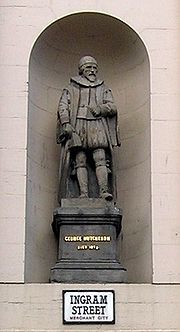
Alexander Stoddart
Alexander Stoddart is a Scottish sculptor, who, since 2008, has been Her Majesty's Sculptor in Ordinary in Scotland. He works primarily on figurative sculpture in clay within the neoclassical tradition...
. Inside the centre a distinctively modern man is rather amusingly struck by the same object of interest as his dog.
Gordon Street
The Citizen Firefighter statue is a bronze sculpture made by sculptor Kenny Hunter and commissioned by the Strathclyde Fire Brigade. The statue depicts a firefighter and represents a tribute to all firefighters past and present who have served in the Strathclyde Fire & Rescue. Three months after it was unveiled (on 17th June 2001) the statue became a focal point for the people of Glasgow to leave flowers and tributes to the firefighters who died in and after the events of Tuesday September 11th in New York .Woodlands Road
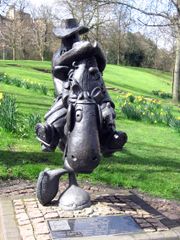
Bud Neill
Bud Neill was a Scottish cartoonist who drew cartoon strips for a number of Glasgow based newspapers between the 1940s and 1960s. Following his death, his work has attained cult status with a worldwide following.-Early life:...
, erected by the citizens of Glasgow. The statue depicts Lobey Dosser, the Sheriff of Calton Creek, taking in his handcuffed arch-enemy Rank Bajin, on his horse El Fideldo (Elfie) which only has two legs. Claimed to be the only two-legged equestrian statue in the world.

